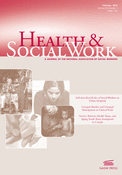-
Views
-
Cite
Cite
Jennifer A. Shadik, Nathan H. Perkins, Pamela J. Kovacs, Incorporating Discussion of Sibling Violence in the Curriculum of Parent Intervention Programs for Child Abuse and Neglect, Health & Social Work, Volume 38, Issue 1, February 2013, Pages 53–57, https://doi.org/10.1093/hsw/hls066
Close - Share Icon Share
Extract
Physical and emotional violence among siblings is one aspect of family dynamics that is often overlooked by practitioners working with children and families receiving services for abuse and neglect. One reason for this may be the limited attention that violence between siblings has received in comparison with other forms of family violence. Button and Gealt (2010) noted the need for more research in this area as well as increased efforts to prevent this form of family violence. One national study identified sibling violence as the most common form of family violence (Straus, Gelles, & Steinmetz, 1980); others have concluded that sibling conflict is rather typical, stating that it occurs daily for approximately 50 percent of young children (Dunn & Kendrick, 1982). The effects of sibling violence can lead to poor peer relations and behavioral problems (Stormshak, Bellanti, & Bierman, 1996); depression and anxiety (Duncan, 1999); and continued self-blame, depression, substance abuse, eating disorders, interpersonal relationship problems, and posttraumatic stress disorder (PTSD) (Wiehe, 1997). Sibling violence has also been associated with the occurrence of peer bullying (Ensor, Marks, Jacobs, & Hughes, 2010; Finkelhor, Turner, & Ormrod, 2006), suggesting that this form of family violence may have indirect implications for the health of others outside the family. However, these findings seem to have had limited inclusion in intervention programs serving children and families.





